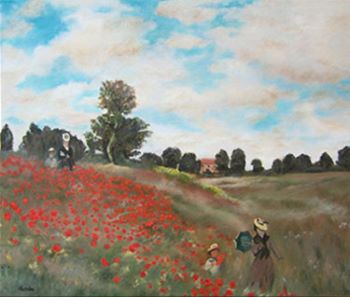
|
|
Let's Talk About "Original" Art Original implies unique, one-of-a-kind. Is Your Art Original? (Definitions are a Murky Business) Look at the similarities between the works of DaVinci and Michelangelo, and Monet and Renoir Copying has been going on for a l--o--n--g time. Artwork created from magazine photos or other works in print, including advertising, is not considered original. If work is created from a photo, the photo MUST be that of the artist (or used with the permission of the photographer or the copyright holder). Under guidelines of most organizations, the creative process of painting and decision making determines how the final work of art is classified. The end result may range from abstract to photo-realistic, but 100 percent of the painting must be created by the artist’s hand in order to be defined as “original.” Most of the masters began by copying. If they did it - you can do it too, but don't carry it too far. Study their techniques, and then go on to express yourself by developing your own subject matter in your own style. Is it legitimate to copy another person's painting? Of course it is - if your intention is solely to learn from that experience. In fact, it is a good idea. Pick a simple painting which interests you and copy the form and the color as best you can. You will learn a great deal about color, mixing, and brush techniques. 
Monet's Version - Wild Poppies Near Argenteuil 
Cheryl's Version Copy in order to learn. The law is clear that no one can make a substantial copy of another’s protected (copyrighted) work, but the application of this simple rule is difficult. If you wish to use the creative works of others for mere inspiration, you certainly may do so, but the use can go no further than that. There are statements to the effect that changing a work by 10 percent, 20 percent or some other specified percentage will avoid violation of the copyright statute. This is untrue since there are no cases or statutes providing any percentage that can be considered safe. The law uses the substantial similarity test. As to the meaning of this test, one of the leading copyright jurists in the United States, Judge Learned Hand, stated that, in his opinion, if one compares the protected original work to the allegedly infringing work and the comparison discloses that the works are substantially similar, then there is an infringement. This is a very subjective test, and those artists who copy the works of others run a great risk that a judge could conclude that the line between inspiration and copying has been crossed. Take great care when using the works of others for inspiration. Do the research and determine if the work is protected by copyright, or in the public domain, and available to be used with no restrictions. Click here to go to Blog 8. All works original and © Copyright of the Artist, Cheryl Hardin. chardinart.com © Copyright 2006-2024 Cheryl Hardin. All Rights Reserved. USA. |